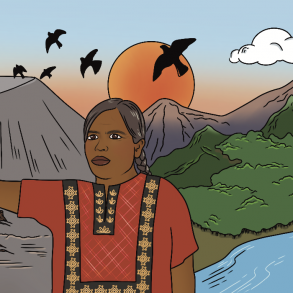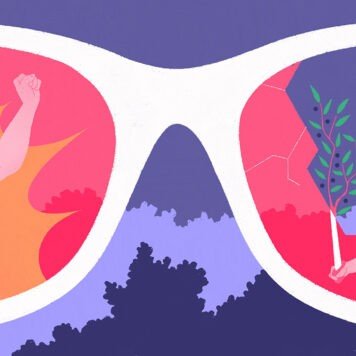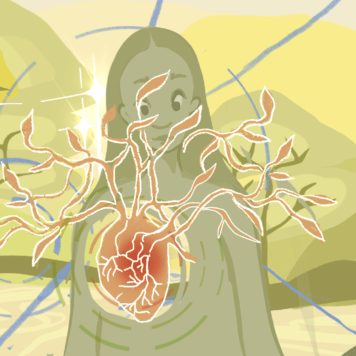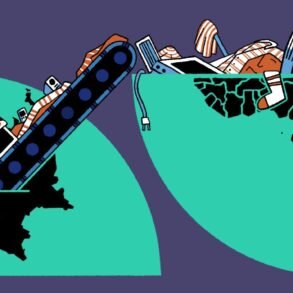What are climate reparations?
The word reparations comes from the Latin word reparare which means to restore or put back in order. Historically, it was used to refer to compensation for war damages from World War I.
Descendants of enslaved Africans have long called for reparations for the historical injustices and human rights abuses whose impacts outlive the abolition of slavery. The term recognises historical injustices caused by a country or group of people towards another country or group of people. The reparations, either in the form of funding or resources, are then often facilitated by governments towards the victims of the injustice.
In that same spirit, climate reparations refer to compensation for climate impacts experienced by communities most vulnerable and least responsible for the climate crisis. Movements for climate reparations posit that these should be paid by those most responsible and least vulnerable. Namely, the Global North – including countries such as the US and EU member states, multinational companies, and the richest 1%. But that’s not what’s happening.
The money pouring into climate finance is nowhere near the amount that is needed to address the impacts already facing communities; moreover, the majority of finance currently comes in the form of loans to the Global South. This means countries and communities most vulnerable go into debt in order to deal with the impacts of the climate crisis – and then owe this debt to the countries that caused the climate crisis.
Today, the most common use of the term climate reparations refers to climate finance to address “Loss and Damage.” These are the losses and damages incurred from climate impacts such as damage to infrastructure, including homes, destroyed crops, farming tools, and fishing tools, but also, lost lives, land, health, biodiversity, cultures, and more.
But climate reparations and what falls under this umbrella isn’t necessarily as simple as that – so in order to truly answer the question, we need to dive into other things first.
How do reparations differ from ‘aid’?
Climate reparations differ from aid because it recognises the responsibility of the “developed” or Global North countries that have historically contributed the most to the climate crisis.
It emphasises that, unlike aid, reparations are not voluntary. There is an obligation based on human rights and environmental justice to pay up for the destruction experienced due to the climate crisis.
Aid, while helpful, is more short term and doesn’t have the same aim as reparations to restore. Aid is an act of charity and terming climate reparations or climate finance as aid puts us in a trap of continuing the narrative that the “rich,” “developed,” and often majority white countries of the North need to help and save the “poor,” “developing” countries of the South – which are economically marginalised and made up mainly of people of colour.
We have to be very clear that climate finance is not aid but rather, should be reparations to fix what’s been broken.
What are the links between capitalism, colonialism and reparations?
UN climate reports have confirmed that human activity has caused the rapidly changing climate that we know today as the climate crisis – but let’s interrogate that a bit more.
A very specific group of humans have contributed far greater than everyone else. Latest reports have shown that only 100 companies contribute to over 70% of carbon dioxide emissions. Reports also show that the richest 1% contribute more than half of emissions of the world’s 50% poorest.
Emissions started rising in the 1800s during the industrial revolution – the dawn of capitalism. This was when we began to see the global average temperature rise at a faster rate than usual.
In a capitalist system, overproduction runs rampant with the aim of continuous wealth for the few. This comes at the cost of environmental plunder and oppression of peoples for natural resources and cheap labour in order to maximise profits. These are the same countries that colonised Global South countries in order to exploit natural resources under the guise of trade.
Put simply, through these endeavours, forests were destroyed, overly destructive mines were built, and the machines they used to process these resources led to emissions rising.
The system that wants uncontrolled everlasting profit on a planet with finite resources made us overly dependent on fossil fuels that primarily benefit the industrialised countries. It has kept colonies and neo-colonies – the countries also most vulnerable to the crisis – deliberately stunted to remain dependent on North countries for surplus products and so they can keep extracting cheap resources and labour.
This means our countries in the South are not able to adapt because of the lack of support for research, technology, and infrastructure needed. A glaring example of this is when the largest polluters block meaningful climate action, especially in the realm of climate finance and reparations meant to be used for adaptation and addressing loss and damages. This was clearly seen in 2021, during COP 26, before the Loss and Damage fund was established in COP 27, the US and EU blocked the establishment of the fund and only supported technical assistance.
The latest UN climate reports have clearly stated that colonialism has made countries more vulnerable to the climate crisis. Colonisers have a responsibility to pay reparations for increasing that vulnerability and causing the climate crisis.
Why is the language of reparations important?
Using the term reparations recognises that something is wrong and broken, someone was hurt, and someone was responsible for that.
While the term “Loss and Damage” being recognised in formal negotiations is a massive step in addressing the climate crisis, the use of this term erases the obligation and liability of those most responsible for the climate crisis, and ignores the loss and damage that has already happened in the past.
It is important therefore to call urgent and much needed climate finance as reparations so they come in the form of grants and not loans, and so they are given, not as an act of charity, but as an act of responsibility and accountability.
What are climate reparations?
If reparations are an effort for the offending group to repair what’s been broken, then to understand climate reparations, we need to understand what we’re trying to restore.
The climate crisis is a symptom of the current rotting profit-oriented economic system. That is the reason why the climate crisis is happening, why marginalised communities are not able to adapt, and why so much has been lost and damaged. That is the injustice that we are trying to repair. And so climate reparations are one way to try and help us to restore a better world.
“Loss and Damage” finance falls under climate reparations, but that’s not all that falls under reparations. To restore our world into a better, safer, and climate just world, climate reparations should also include compensation for direct impacts of the destruction fossil fuel industries have caused on communities on their health, livelihood, homes, environment, etc. It should also include other forms of climate finance for adaptation and a just transition. But it can’t stop there.
As Historian Lisa Betty says, “reparations are more than financial restitution…. Reparations are world-making, society transforming interventions.” Reparations must include technology transfer, capacity building, laws, and policies to ensure that the most marginalised are listened to and prioritised. All this and more are what we need to build a sustainable future and a better world. What we’re trying to restore is justice and that starts with money but does not end there.
Why is it a global issue and who is most impacted by a lack of reparations?
The fight for climate reparations must be a global one because it is one of the first steps needed to restore and rebuild a better world – one where no one is left behind and starts to address the root of the problem: capitalism and gross wealth inequality.
The richest of the world and the multinational companies in the Global North that have caused the climate crisis must pay their debt to the people that have been harmed by their greed and their actions.
Without these reparations, countries and communities most impacted by and least responsible for the climate crisis will continue to go through increasing economic crises to manage and try to adapt to climate impacts. The world will also continue to warm without the reparations invested in renewable, sustainable energy.
This world cannot exist without everyone joining the fight. Together, across the world, we must call for reparations. Fight for loss and damage, adaptation and mitigation finance, but also policy change, technology transfer, and prioritisation of the most marginalised. The fight for reparations is our right and our fight to restore a better, safer, greener world.
Who is leading the movement?
- Debt for climate
- Loss and Damage Collaboration
- Loss and Damage Youth Coalition
- Pan-African Climate Justice Alliance
- Pacific Islands Climate Action Network
- Asia Pacific Forum on Women, Law and Development
- Climate Justice Alliance in the US
- Fridays for Future, Rise Up, and other youth groups
- Youth Advocates for Climate Action Philippines
What can you do?
- Read Reconsidering Reparations by Olufemi Taiwo
- Follow Olufemi Taiwo on Twitter
- Reparations and Climate Justice: A Call for Black Sustainable Futures by Lisa Betty
- Ecological Debt Report by UNEP
- A Guide to Climate Reparations
- Listen to Hot Take: Climate Reparations
- Read The new ‘bond-age’, climate crisis and the case for climate reparations
- Listen to Keston K. Perry on Climate Reparations for the Global South
- Follow Keston K. Perry on Twitter
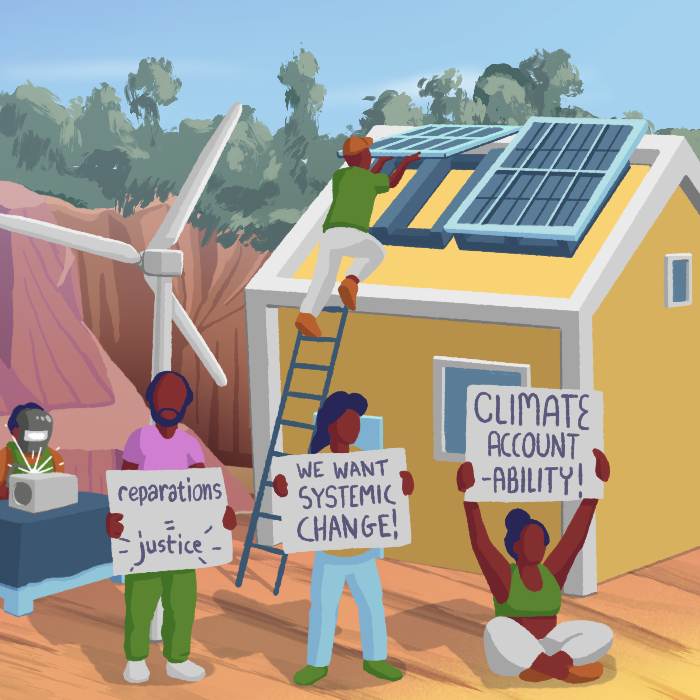 Illustration by Walker Gawande @walker_gawande: “In this illustration, I wanted to capture the ecological devastation of modern-day colonialism orchestrated by western corporations in the global south, which is why I chose a stripmine as the backdrop. At the same time, I wanted the main focus to be on what can be achieved through climate reparations, which is why I included protestors, to signify the struggle for justice, alongside workers who are focused on building a just and resilient energy transition.”
Illustration by Walker Gawande @walker_gawande: “In this illustration, I wanted to capture the ecological devastation of modern-day colonialism orchestrated by western corporations in the global south, which is why I chose a stripmine as the backdrop. At the same time, I wanted the main focus to be on what can be achieved through climate reparations, which is why I included protestors, to signify the struggle for justice, alongside workers who are focused on building a just and resilient energy transition.”



